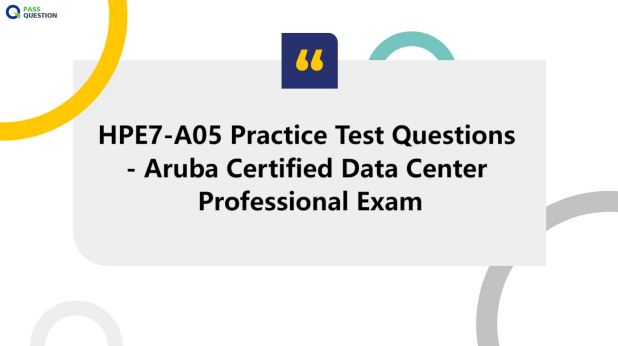HPE7-A05 Practice Test Questions - Aruba Certified Data Center Professional Exam
Posted in CategoryStandard Arabic Vocabulary Questions-
PPassquestion 2 weeks ago
Preparing for the HPE7-A05 Aruba Certified Data Center Professional Exam can be a challenging yet rewarding journey. This certification validates your expertise in designing, implementing, and managing Aruba data center solutions. To ensure your success on this critical exam, it's essential to utilize comprehensive study materials that thoroughly cover all exam objectives. The latest HPE7-A05 Practice Test Questions from PassQuestion are specifically designed to do just that. These practice questions not only reflect the current exam content but also provide detailed explanations to help you understand key concepts and reinforce your knowledge. By integrating these HPE7-A05 Practice Test Questions into your study routine, you'll be able to approach the exam with greater confidence and achieve the certification you're aiming for.

HPE7-A05 Aruba Certified Data Center Professional Exam
This exam validates the candidate has the knowledge and skills required to design, deploy, and manage secure, scalable, resilient, and high-performing data center network infrastructure based on HPE Aruba Networking data center products. Typical candidates have a minimum of three years of experience implementing and supporting data center networks.
They can:- Design and validate data center networks that meet customer requirements.
- Deploy HPE Aruba Data Center Networking switches into greenfield or brownfield network environments.
- Integrate data center networking switches with other products such as servers, storage, hypervisors, etc. from HPE or 3rd party vendors.
- Troubleshoot, monitor, and maintain the data center network.
Exam Details
Exam ID: HPE7-A05
Exam type: Proctored
Exam duration: 2 hours
Exam length: 75 questions
Passing score: 65%
Delivery languages: English, Latin American Spanish, JapaneseHPE7-A05 Exam Topics
1. Plan the low-level design 14%
- 1.1 Based on a high-level network design, create a low-level design for deployment based on HPE Aruba Networking data center switches
- 1.2 Based on the low-level design, create and/or validate the BoM
- 1.3 Determine if the physical environment and data center infrastructure meet the needs of the solution and recommend changes as needed.
2. Install the solution 13%
- 2.1 Stage the network equipment to enable testing prior to the final installation
- 2.2 Execute the physical installation of equipment
- 2.3 Validate the installation
3. Configure the solution 23%
- 3.1 Using various interface mechanisms, implement the low-level design
- 3.2 Verify that the configuration meets the design requirements
- 3.3 Configure monitoring tools
4. Troubleshoot 15%
- 4.1 Diagnose issues using embedded diagnostic tools
- 4.2 Determine the severity of issues and develop a plan of action to remediate the problem
- 4.3 Resolve the issues using the appropriate tools
5. Create a monitored environment 12%
- 5.1 Use available monitoring and reporting tools to monitor performance, availability, and system resources
- 5.2 Establish baselines and define alert thresholds
- 5.3 Generate reports to determine switch and data center health
6. Maintain and optimize 12%
- 6.1 Monitor HPE and third-party release cycles
- 6.2 Maintain licenses and subscriptions
- 6.3 Optimize traffic
- 6.4 Optimize security
- 6.5 Optimize automation
7. Integration 11%
- 7.1 Implement specific switch features that integrate and interoperate with server, storage, workload, and applications
View Online Aruba Certified Data Center Professional Exam HPE7-A05 Free Questions
1. When planning the low-level design of a data center solution, what should be evaluated to ensure scalability?
A. Operating hours
B. Employee training
C. Software compatibility
D. Equipment capacity
Answer: D2. What diagnostic tool is commonly used to troubleshoot network connectivity issues by tracing the path a packet takes from source to destination?
A. Traceroute
B. Performance monitoring
C. System logs
D. Packet sniffing
Answer: A3. In the low-level design phase, what is the purpose of creating diagrams or visual representations of the data center solution layout?
A. Entertainment purposes
B. Clear documentation
C. Aesthetics
D. Easy access to snacks
Answer: B4. What is a primary objective when planning the low-level design of a data center solution?
A. Improving efficiency
B. Increasing downtime
C. Expanding server space
D. Reducing costs
Answer: A5. When installing an Aruba Certified Data Center solution, which key factor should be considered for optimal performance?
A. Load balancing
B. Hardware compatibility
C. Network security
D. Power consumption
Answer: B6. Which tool can be used to monitor network traffic and performance in an Aruba data center environment?
A. Aruba Central
B. Aruba IntroSpect
C. Aruba ClearPass
D. Aruba AirWave
Answer: D7. When maintaining and optimizing a data center, why is it important to conduct regular capacity planning?
A. To experience frequent downtime
B. To waste resources
C. To ensure scalability
D. To ignore future growth
Answer: C8. Which diagnostic tool in Aruba Data Center can assist in identifying and troubleshooting WAN connectivity issues?
A. AirWave
B. RFProtect
C. Network Insight
D. NetEdit
Answer: C9. Which of the following is a key consideration when planning the low-level design of a data center solution?
A. Customer feedback
B. Security protocols
C. Social media presence
D. Bandwidth requirements
Answer: B10. Which of the following features is important to consider when configuring network redundancy in a data center solution?
A. Network slicing
B. Cloud storage
C. Broadcast storms
D. Link aggregation
Answer: D


